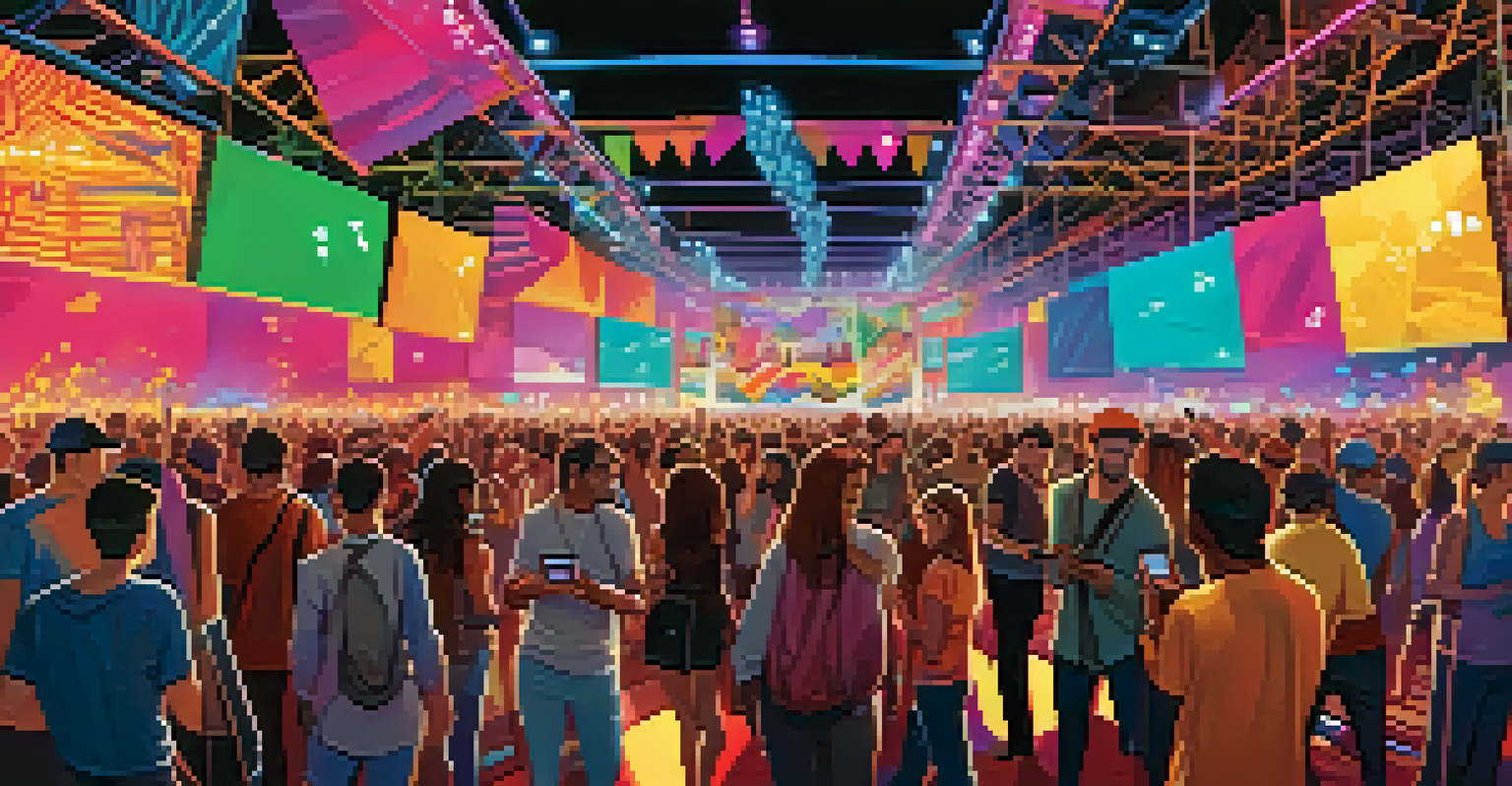Augmented Reality Marketing: Leveraging NFTs for Engagement

Understanding Augmented Reality in Marketing
Augmented Reality (AR) is transforming how brands interact with consumers. Imagine walking into a store and using your phone to see additional product information superimposed on the items right in front of you. This blend of physical and digital worlds creates an immersive shopping experience that captivates customers and drives sales. By integrating AR, brands can make their marketing campaigns more dynamic and engaging.
Augmented Reality is a game changer for brands looking to connect with consumers in a more engaging way.
One of the key benefits of AR is its ability to create memorable interactions. For example, a furniture retailer can allow customers to visualize how a piece of furniture would look in their own homes before making a purchase. This not only enhances the decision-making process but also builds a deeper emotional connection between the customer and the brand.
With the rising popularity of mobile devices, AR is more accessible than ever. Brands can leverage simple apps or social media filters to enhance their reach and appeal. As consumers increasingly seek personalized experiences, AR offers a unique way to stand out in a crowded market.
The Rise of NFTs: What You Need to Know
Non-Fungible Tokens (NFTs) have taken the digital world by storm. Unlike cryptocurrencies that are interchangeable, NFTs represent unique digital items, making them ideal for collectors and creators alike. They can take the form of digital art, music, or even virtual goods, which adds a layer of exclusivity to marketing efforts. This uniqueness is what makes NFTs so appealing in a marketing context.

Imagine a brand releasing limited-edition digital artwork as NFTs that can only be accessed by users who engage with their AR experiences. This not only incentivizes participation but also creates a sense of community among customers who own these exclusive items. It's a new way for brands to reward loyalty and encourage engagement.
AR Enhances Customer Engagement
Augmented Reality creates immersive shopping experiences that captivate consumers and deepen their emotional connections with brands.
As the NFT market evolves, brands are finding innovative ways to integrate these tokens into their marketing strategies. From virtual event tickets to gamified experiences, the possibilities are endless. This trend highlights the growing importance of digital ownership in consumer culture.
Combining AR and NFTs for Engagement
When combined, AR and NFTs can elevate marketing campaigns to new heights. Imagine scanning a product with your phone and instantly unlocking an exclusive NFT artwork that represents that product. This fusion creates a unique experience that not only promotes the product but also offers something valuable to the consumer. It's like giving customers a digital collectible that enhances their connection to the brand.
NFTs offer a unique opportunity for brands to create exclusive experiences that resonate with their audience.
For instance, a fashion brand could release AR try-on features that allow customers to see how virtual clothing looks on them. Upon completing the experience, customers could receive an NFT representing their virtual outfit. This kind of interaction not only boosts engagement but also encourages sharing on social media, amplifying the brand’s reach.
Moreover, this synergy allows brands to tap into the growing interest in digital collectibles. As consumers seek out unique experiences, the combination of AR and NFTs offers a fresh avenue to capture their attention and foster brand loyalty.
Creating Memorable Customer Experiences
The ultimate goal of marketing is to create memorable experiences for customers. By integrating AR and NFTs, brands can craft interactive campaigns that resonate on a personal level. These technologies allow for storytelling that goes beyond traditional methods, immersing customers in the narrative of the brand.
Consider a music festival where attendees can scan AR codes at various stages to unlock exclusive NFT content from their favorite artists. This creates a layered experience where fans not only enjoy the music but also collect unique digital memorabilia. Such interactions leave lasting impressions, making customers more likely to return.
NFTs Offer Unique Digital Ownership
Non-Fungible Tokens provide brands with a way to create exclusive digital items that enhance marketing efforts and foster community among consumers.
As brands continue to explore these technologies, the emphasis on customer experience will only grow. By focusing on creating engaging and personalized interactions, brands can foster loyalty and advocacy in an increasingly competitive landscape.
Challenges in Implementing AR and NFTs
While the potential of AR and NFTs is exciting, there are challenges brands must navigate. One major hurdle is the technological barrier; not all customers may have access to the devices or internet speeds necessary for an optimal experience. Brands need to ensure that their AR applications are user-friendly and accessible to a broad audience.
Additionally, the NFT space is still relatively new and can seem overwhelming to both brands and consumers. Educating customers on the value and usage of NFTs is crucial for successful implementation. Clear communication can demystify the process and encourage participation, making it essential for brands to invest time in consumer education.
Lastly, the environmental impact of NFTs is a growing concern. Many brands are exploring eco-friendly blockchain solutions to mitigate this issue. By addressing these challenges head-on, brands can create responsible and inclusive marketing strategies that resonate with their audiences.
Real-World Examples of AR and NFTs in Action
Several brands are already harnessing the power of AR and NFTs to engage customers. For instance, a popular beverage company recently launched a campaign where customers could scan their drink labels to access AR experiences featuring virtual concerts. In addition, customers who participated received limited-edition NFTs, making the experience even more enticing.
Similarly, a global shoe brand introduced an AR app that allows users to 'try on' shoes virtually. Once users complete the experience, they can unlock an exclusive NFT that represents their chosen style. This not only drives engagement but also creates a buzz on social media as customers share their experiences.
Combining AR and NFTs for Innovation
Integrating AR with NFTs allows brands to craft interactive campaigns that not only promote products but also deliver valuable digital collectibles to consumers.
These real-world examples illustrate how brands can successfully integrate AR and NFTs into their marketing strategies. As more brands explore this combination, we can expect to see even more innovative applications that push the boundaries of customer engagement.
The Future of AR and NFTs in Marketing
Looking ahead, the future of AR and NFTs in marketing is bright. As technology continues to advance, we can expect to see even more seamless integrations that enhance customer experiences. Brands that embrace these innovations will likely find themselves ahead of the curve, attracting tech-savvy consumers eager for unique interactions.
Moreover, as the NFT market matures, brands will have more opportunities to explore creative ways to engage their audiences. From loyalty programs that reward customers with NFTs to AR experiences that bring products to life, the potential is vast. This evolving landscape will challenge brands to think outside the box and innovate continuously.

Ultimately, the successful integration of AR and NFTs will rely on understanding consumer behavior and preferences. By staying attuned to trends and feedback, brands can create meaningful connections with their audiences, ensuring that their marketing efforts resonate in an increasingly digital world.